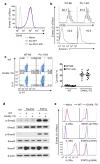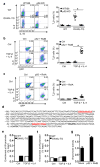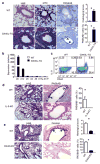OX40 signaling favors the induction of T(H)9 cells and airway inflammation
- PMID: 22842344
- PMCID: PMC3806044
- DOI: 10.1038/ni.2390
OX40 signaling favors the induction of T(H)9 cells and airway inflammation
Abstract
The mechanisms that regulate the T(H)9 subset of helper T cells and diseases mediated by T(H)9 cells remain poorly defined. Here we found that the costimulatory receptor OX40 was a powerful inducer of T(H)9 cells in vitro and T(H)9 cell-dependent airway inflammation in vivo. In polarizing conditions based on transforming growth factor-β (TGF-β), ligation of OX40 inhibited the production of induced regulatory T cells and the T(H)17 subset of helper T cells and diverted CD4(+)Foxp3(-) T cells to a T(H)9 phenotype. Mechanistically, OX40 activated the ubiquitin ligase TRAF6, which triggered induction of the kinase NIK in CD4(+) T cells and the noncanonical transcription factor NF-κB pathway; this subsequently led to the generation of T(H)9 cells. Thus, our study identifies a previously unknown mechanism for the induction of T(H)9 cells and may have important clinical implications in allergic inflammation.
Conflict of interest statement
COMPETING INTERESTS STATEMENT
The authors have no conflict of interests to declare.
Figures









Comment in
-
Yoking OX40 to regulation of IL-9.Nat Immunol. 2012 Oct;13(10):942-3. doi: 10.1038/ni.2421. Nat Immunol. 2012. PMID: 22990899 Free PMC article.
Similar articles
-
Yoking OX40 to regulation of IL-9.Nat Immunol. 2012 Oct;13(10):942-3. doi: 10.1038/ni.2421. Nat Immunol. 2012. PMID: 22990899 Free PMC article.
-
OX40-OX40 ligand interaction in T-cell-mediated immunity and immunopathology.Adv Immunol. 2010;105:63-98. doi: 10.1016/S0065-2776(10)05003-0. Adv Immunol. 2010. PMID: 20510730 Review.
-
Guidance of super-enhancers in regulation of IL-9 induction and airway inflammation.J Exp Med. 2018 Feb 5;215(2):559-574. doi: 10.1084/jem.20170928. Epub 2018 Jan 16. J Exp Med. 2018. PMID: 29339447 Free PMC article.
-
The OX40/OX40L Axis Regulates T Follicular Helper Cell Differentiation: Implications for Autoimmune Diseases.Front Immunol. 2021 Jun 21;12:670637. doi: 10.3389/fimmu.2021.670637. eCollection 2021. Front Immunol. 2021. PMID: 34234777 Free PMC article. Review.
-
OX40/OX40L costimulation affects induction of Foxp3+ regulatory T cells in part by expanding memory T cells in vivo.J Immunol. 2008 Sep 1;181(5):3193-201. doi: 10.4049/jimmunol.181.5.3193. J Immunol. 2008. PMID: 18713990
Cited by
-
STAT5 promotes accessibility and is required for BATF-mediated plasticity at the Il9 locus.Nat Commun. 2020 Sep 28;11(1):4882. doi: 10.1038/s41467-020-18648-6. Nat Commun. 2020. PMID: 32985505 Free PMC article.
-
Dectin-1-activated dendritic cells trigger potent antitumour immunity through the induction of Th9 cells.Nat Commun. 2016 Aug 5;7:12368. doi: 10.1038/ncomms12368. Nat Commun. 2016. PMID: 27492902 Free PMC article.
-
B lymphocyte-induced maturation protein 1 controls TH9 cell development, IL-9 production, and allergic inflammation.J Allergy Clin Immunol. 2019 Mar;143(3):1119-1130.e3. doi: 10.1016/j.jaci.2018.06.046. Epub 2018 Aug 7. J Allergy Clin Immunol. 2019. PMID: 30096391 Free PMC article.
-
Fas signaling-mediated TH9 cell differentiation favors bowel inflammation and antitumor functions.Nat Commun. 2019 Jul 2;10(1):2924. doi: 10.1038/s41467-019-10889-4. Nat Commun. 2019. PMID: 31266950 Free PMC article.
-
TNF-α enhances Th9 cell differentiation and antitumor immunity via TNFR2-dependent pathways.J Immunother Cancer. 2019 Feb 4;7(1):28. doi: 10.1186/s40425-018-0494-8. J Immunother Cancer. 2019. PMID: 30717817 Free PMC article.
References
-
- Janeway CA, Bottomly K. Signals and signs for lymphocyte responses. Cell. 1994;76:275–285. - PubMed
-
- Li XC, Rothstein DM, Sayegh MH. Costimulatory pathways in transplantation: challenges and new developments. Immunological Reviews. 2009;229:271–293. - PubMed
-
- Dong C. Diversification of T helper cell lineages: finding the family root of IL-17-producing cells. Nat Rev Immunol. 2006;6:329–334. - PubMed
-
- Bettelli E, et al. Reciprocal developmental pathways for the generation of pathogenic effector Th17 and regulatory cells. Nature. 2006;441:235–238. - PubMed
-
- Staudt V, et al. Interferon-regulatory factor 4 is essential for the developmental program of T helper 9 cells. Immunity. 2010;33:192–202. - PubMed
Publication types
MeSH terms
Substances
Grants and funding
LinkOut - more resources
Full Text Sources
Other Literature Sources
Molecular Biology Databases
Research Materials
Miscellaneous

